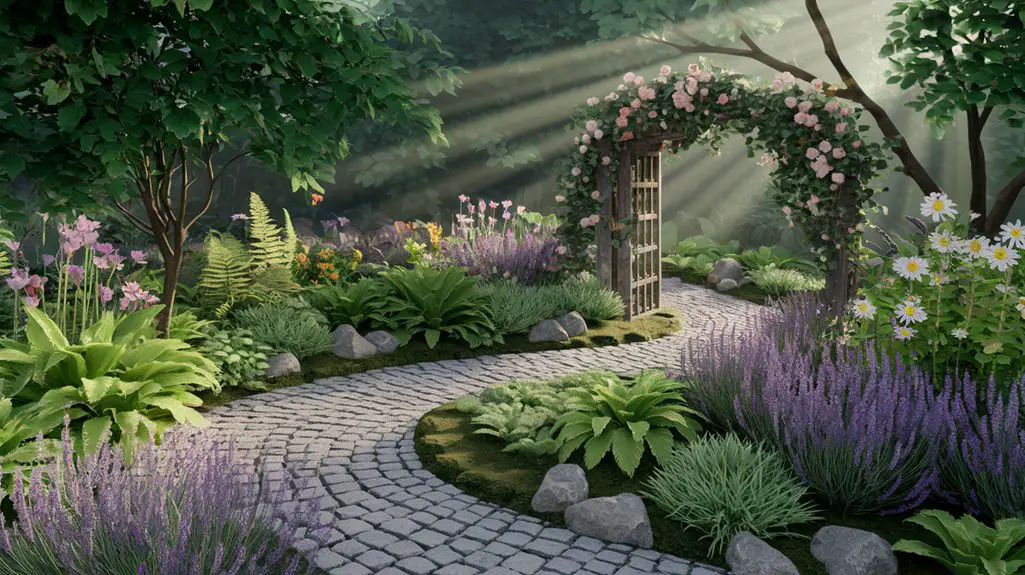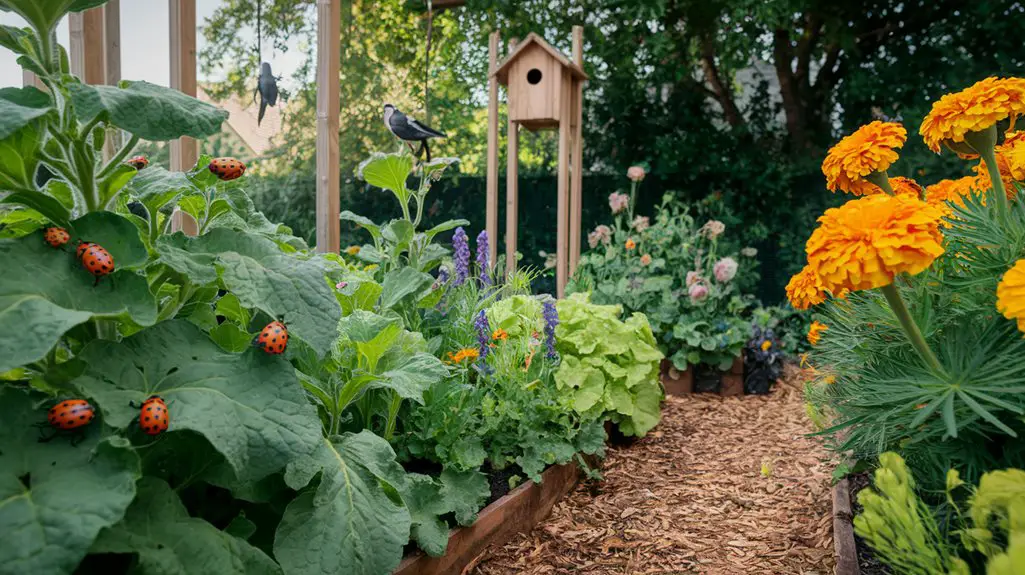You’re about to transform ordinary garden pathways into functional art that connects spaces while expressing your unique vision. Beyond mere navigation routes, thoughtfully designed paths integrate with your landscape’s ecology, enhancing biodiversity and managing water flow. Consider how materials, textures, and patterns might reflect your garden’s character while addressing practical concerns like maintenance and seasonal changes. The difference between a conventional walkway and an inspired pathway lies in details you haven’t yet considered.
Enchanting Mosaic Stone Pathways for Artistic Expression
Mosaics transform ordinary garden pathways into extraordinary statements of personal creativity and ecological harmony. By integrating locally-sourced stone fragments, recycled ceramic pieces, and tumbled glass, you’ll create sustainable pathways that minimize environmental impact while maximizing visual appeal.
When designing your mosaic pathway, consider complementary color schemes that reflect your garden’s palette. Select materials with varying textures—smooth river stones contrast beautifully with rough-hewn granite chips.
Install a properly-prepared substrate of sand and gravel (4-6 inches deep) to prevent settling and guarantee drainage.
For durability in frost-prone regions, apply a penetrating eco-friendly sealant to protect your artistic investment. Incorporating creative water features can further enhance your garden’s ambiance, creating a serene atmosphere that complements your mosaic design.
Position solar-powered accent lighting alongside to illuminate intricate patterns after sunset, extending your pathway’s functional hours while highlighting its craftsmanship without increasing your carbon footprint.
Rustic Reclaimed Wood and Railroad Tie Walkways

Repurposed with environmental mindfulness, rustic wood and railroad tie pathways offer compelling alternatives to conventional hardscaping while diverting materials from landfills.
These elements integrate seamlessly with garden ecosystems, developing rich patinas as they weather and host beneficial fungi and microorganisms.
When installing, place ties or planks atop 2-3 inches of compacted gravel for drainage and stability.
You’ll need to treat untreated wood with eco-friendly preservatives containing borate or linseed oil. For railroad ties, select those free from creosote contamination to prevent toxin leaching.
Space elements slightly apart to allow groundcover plants like thyme or moss to establish between gaps, creating living mortar that prevents slippage and enhances biodiversity. Sustainable garden path designs exemplify the creative potential of using recycled materials in landscaping.
The pathway’s decomposition cycle ultimately enriches your soil, exemplifying true cyclical design thinking.
Illuminated Garden Paths for Nighttime Magic

Why limit your garden’s allure to daylight hours when strategic illumination can transform pathways into enchanting nighttime corridors? Low-voltage LED systems offer energy-efficient solutions that minimize ecosystem disruption while maximizing visibility and aesthetic appeal. Consider solar-powered path lights with photovoltaic cells that harvest daylight and automatically activate at dusk—a carbon-neutral approach requiring no external wiring. For more dramatic effects, install recessed ground fixtures that cast light upward through foliage, creating dynamic shadow play on surrounding surfaces. Integration of smart controls allows you to program illumination intensity based on time, weather conditions, and motion detection. Select fixtures with full-spectrum cutoff designs that direct light downward, preserving nocturnal wildlife habitats and reducing light pollution. Additionally, incorporating pathway lighting options can enhance both safety and style, making your outdoor space inviting after sunset. Your illuminated pathway then becomes both functional navigation and an extension of your garden’s ecological harmony.
Whimsical Stepping Stone Designs With Personal Flair
How might your garden pathway transcend mere functionality to become an expression of your unique personality? Consider crafting personalized stepping stones that marry ecological consciousness with artistic expression.
Repurpose broken ceramics in mosaic patterns for a zero-waste approach, embedding them in DIY concrete casts made from recyclable molds. You’ll achieve ideal durability by maintaining a 2:1:3 ratio of sand, cement, and aggregate. Additionally, you can explore various garden pathway ideas that incorporate different materials and designs for further inspiration.
For biodiversity support, design stones with small water-collecting depressions that serve as insect watering stations. Integrate native plant imprints by pressing local leaves or flowers into partially set concrete. These impressions aren’t merely decorative—they remind visitors of indigenous flora.
Position your stones at 55-60cm intervals to accommodate natural stride length while allowing interstitial growth of low-profile ground covers like creeping thyme, which release aromatics with each footfall.
Living Pathways With Aromatic Herbs and Ground Covers
Beyond the stepping stones themselves lies a canvas of opportunity—the spaces between. Transform these gaps into aromatic ecosystems by integrating low-growing herbs that release fragrance when brushed against.
Thyme varieties (Thymus serpyllum, T. praecox) offer exceptional foot tolerance while creeping mint (Mentha requienii) provides surprising resilience in partially shaded areas.
Consider your microclimate when selecting ground covers. Drought-prone pathways benefit from sedum and sempervivum, while damper zones support moisture-loving Corsican mint and sweet woodruff.
Position aromatics strategically—chamomile near seating areas, lavender along sunny borders.
These living pathways serve multiple functions: erosion control, weed suppression, pollinator attraction, and sensory engagement. Additionally, incorporating beneficial insects into your garden through these herb selections can enhance pollination and pest control.
You’ll reduce maintenance while creating biodiversity nodes that connect larger garden ecosystems—each step becoming part of the garden’s ecological narrative.
Water-Friendly Permeable Pathway Solutions
The increasing frequency of extreme weather events demands garden pathways that manage rainwater intelligently rather than contributing to runoff problems.
Permeable pathways allow precipitation to infiltrate directly into soil, protecting watershed health and replenishing groundwater.
You’ll find several effective options for water-friendly installations. Spaced pavers with gravel or sand joints create elegant patterns while maximizing permeability. Crushed stone or decomposed granite pathways provide excellent drainage when installed over proper base layers. For heavier traffic areas, consider permeable concrete pavers specifically engineered with water channels.
When designing your system, incorporate slight slopes (1-2%) away from structures, install deeper drainage beds in areas with clay soils, and position pathways to direct water toward rain gardens or bioswales. Additionally, utilizing budget-friendly materials can enhance the sustainability of your garden pathways without compromising aesthetics.
These thoughtful solutions transform pathways from potential watershed problems into integral components of your garden’s hydrological cycle.
Conclusion
Your garden path isn’t merely a connection between points—it’s an extraordinary ecological masterpiece waiting to be revealed. By implementing these infinitely customizable pathway designs, you’ll transform every square inch into a breathtaking ecological sanctuary that works harmoniously with nature’s systems. Don’t settle for ordinary concrete when you can create a permeable, living, illuminated wonderland that simultaneously manages water flow while expressing your most authentic artistic vision.



